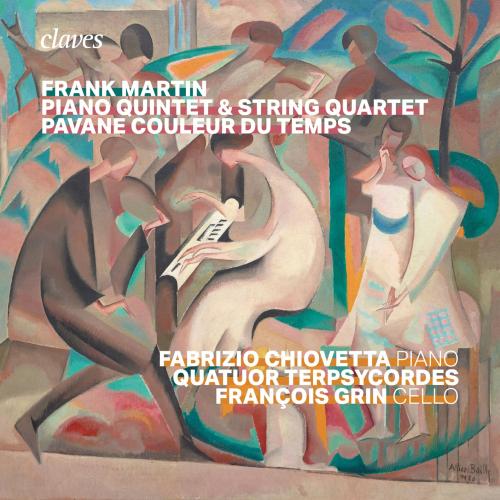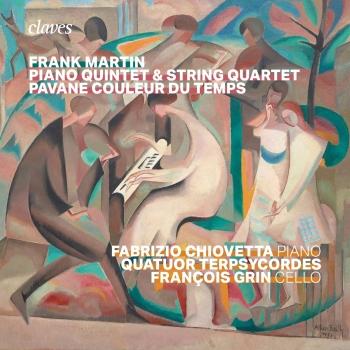
Frank Martin : Piano Quintet, Quartet, Pavane couleur du temps Quatuor Terpsycordes & Fabrizio Chiovetta
Album info
Album-Release:
2024
HRA-Release:
12.04.2024
Label: Claves Records
Genre: Classical
Subgenre: Chamber Music
Artist: Quatuor Terpsycordes & Fabrizio Chiovetta
Composer: Frank Martin (1890-1974)
Album including Album cover
- Frank Martin (1890 - 1974): Piano Quintet:
- 1 Martin: Piano Quintet: I. Andante con moto 06:37
- 2 Martin: Piano Quintet: II. Tempo di minuetto 05:28
- 3 Martin: Piano Quintet: III. Adagio ma non troppo 07:32
- 4 Martin: Piano Quintet: IV. Presto 05:40
- String Quartet:
- 5 Martin: String Quartet: I. Lento 07:04
- 6 Martin: String Quartet: II. Prestissimo 02:46
- 7 Martin: String Quartet: III. Larghetto 06:29
- 8 Martin: String Quartet: IV. Allegretto leggero 03:40
- Pavane couleur du temps, for String Quintet:
- 9 Martin: Pavane couleur du temps, for String Quintet 06:51
Info for Frank Martin : Piano Quintet, Quartet, Pavane couleur du temps
Chamber music meanders throughout Frank Martin’s career in a multitude of different ensembles and titles, ranging from the classical to the more unexpected, such as the Rhapsodie for string quintet with double bass, the Sonata da chiesa for viola d’amore and organ, the Ballade for trombone and piano or the Petite fanfare for brass sextet. Within this abundance, the composer approached only sparingly the most historically established genres. His only string quartet is a late work, his last chamber music piece. On the contrary, the Quintet for piano and strings and the Pavane couleur du temps are among his earliest contributions in this field.
At the end of 1918, Martin married Odette Micheli, and the young couple moved to Zurich. The Quintet for piano and strings was composed in this city a few months later. The work belongs to a period during which the composer’s style gradually freed itself from post-romanticism and became more personal. Martin’s recent meeting with Ernest Ansermet coincided with a marked interest in the music of Claude Debussy and Maurice Ravel, of whom the conductor was a strong advocate. The Quintet bears witness to this influence but goes far beyond it. An unusual conception of this musical genre can already be heard in the very first bars. Over a sorrowful accompaniment by the violins and viola, the cello introduces a plaintive, passionate melody. It is not until the sixteenth bar that the piano makes a timid appearance. With only a few exceptions, the piano remains in the background throughout the piece, confining itself to providing colour or rhythmic support. This is a far cry from the piano quintet tradition, which, from Johannes Brahms to Gabriel Fauré and César Franck, has placed the keyboard on an equal footing with the strings. It is in the minuet that the spirit of Ravel is most explicitly found: the dance is highly stylised here, and both the rhythmic momentum and certain pizzicato and arpeggiated chord effects recall the world of the French composer.
It is often said that the Quintet’s slow movement recalls Frank Martin’s fascination for Johann Sebastian Bach. Admittedly, the haunting triplets that open the piece would not be out of place in a Passion written by the German master, but the analogy doesn’t go much beyond that. The composer creates a perfect sense of chiaroscuro between this sombre accompaniment and the luminous arpeggios of the first violin and the viola. A post-romantic tone is heard here, culminating in the central section where the first violin’s playing in sixths and thirds contributes to a polyphony of exacerbated lyricism while the piano remains silent. The strings alone again play the nearly first sixty bars of the finale. The last movement alternates between fugal writing and more transparent passages, with the composer constantly varying the instrumental textures with much ingenuity. Amid this fireworks display, a popular Savoy melody can even be heard. ...
Fabrizio Chiovetta, piano
Terpsycordes Quartett
Fabrizio Chiovetta
Born in Geneva, Fabrizio Chiovetta, of Swiss and Italian nationality, studied with Elisabeth Athanassova, Dominique Weber, John Perry and Paul Badura-Skoda, of whom he became a privileged disciple.
He has given numerous concerts in Europe, North America, Asia and the Middle East (Menuhin Festival and Sommets musicaux de Gstaad, Princeton Piano Festival, Beijing National Center, Lisztomanias, Festival Berlioz, Shanghai Oriental Art Center, Schloss Elmau), performing under the direction of Gábor Takács-Nagy, Jean-Pascal Hamelin, Arie van Beck and Diego Matheuz. A versatile musician, he is a much sought-after chamber musician, performing with partners such as Gautier Capuçon, Lise Berthaud, Patrick Messina, the Quatuor Belcea, Marc Coppey, Henri Demarquette, Camille Thomas, Pierre Fouchenneret, Sarah Nemtanu, Samuel Hasselhorn, Benjamin Appl, Sophie Karthäuser and Werner Güra; as an improviser, he collaborates with musicians from diverse backgrounds. He also teaches piano at the Haute école de musique in Geneva.
His recordings for Palexa, Claves Records and Aparté have received critical acclaim (Diapason, Choc de Classica, American Record Guide, Gramophone Editor’s Choice).
The Terpsycordes Quartet
redefines the connection between a musical ensemble and its audience. It invents new ways to experience a concert of chamber music and is committed to reaching underprivileged as well as young audiences, in order to share its art with as many people as possible.
Formed in Geneva in 1997, guided by the artistic vision of Gábor Takács-Nagy and nurtured by the teachings of members of the Amadeus, Budapest, Hagen, Lasalle, and Mosaïques quartets, the Terpsycordes Quartet quickly made its mark on the musical scene, notably winning First Prize at the Geneva Competition in 2001, as well as other international competitions (Weimar, Graz, Trapani). Encounters with major 20th century composers such as György Kurtág and Sofia Gubaidulina, as well as personalities from the world of baroque music, including Gabriel Garrido, Chiara Banchini, Florence Malgoire, and Leonardo García Alarcón, contributed to defining and refining the quartet’s aesthetic evolution. Members of the Quartet continue to play regularly with various other ensembles such as Cappella Mediterranea, Gli Angeli Genève, Contrechamps, l’Armée des Romantiques, or Elyma.
The repertoire of the Terpsycordes Quartet spans from the pre-classical period to contemporary creations. Since 2021, it has been performing a complete cycle of Joseph Haydn’s quartets on period instruments at the Museum of Art and History in Geneva, while maintaining a special relationship with major 20th century Genevan composers – Ernest Bloch and Frank Martin. This new album, entirely dedicated to the works of Frank Martin, adds to a discography ranging from Haydn to Piazzolla, widely acclaimed by critics.
The Terpsycordes Quartet is actively engaged in social and educational projects. It offers concerts in partnership with foundations, associations, and facilities for the disabled, those in precarious situations, or in detention. It also collaborates with schools in the City of Geneva. It breaks conventions by offering unique experiences aimed at sharing its passion, including outdoor concerts in unusual locations, musical bike rides, or public rehearsals, thus creating original opportunities to introduce the magic of chamber music to diverse audiences.
The Terpsycordes Quartet is supported by the City of Geneva and by the Republic and Canton of Geneva.
This album contains no booklet.









